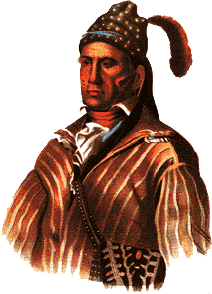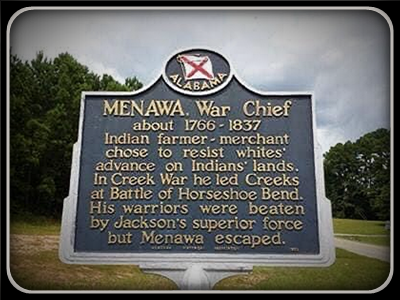

MENAWA became a legendary figure as a leader of the upper Creeks in the war against the U.S. Government in l8l3-1814. The Lower Creeks had already conceded and did not join in the battle at Horseshoe Bend, one of the last heroic stands to save Creek Homelands.
Chief Menawa was born about 1765 at the village of Oakfuskee on the Tallapoosa River. Oakfuskee was located where the lower part of Lake Martin now exists. Menawa was of Scotch and Indian parents and was reared with pride in his Indian heritage. His birth name was Hothlepoya, meaning "Crazy Trouble Hunter," but the name MENAWA was given to him when he became second chief of Oakfuskee. He was a man of wealth and intelligence who was greatly disturbed when he saw white settlers begin to take Indian land and demand the removal of the native inhabitants.
In the Battle of Horseshoe Bend Menawa was second in command of the Creeks against the United States and General Andrew Jackson. Menawa was a realistic military strategist who lost patience with the incantations being used against the U.S. by the prophet Monahell, who was first in command. In a short unpublished biography by J.Y. Brame, Menawa is reported to have killed Monahell during the battle and taken command. Menawa was shot about seven times during the battle and left for dead. He lay on the ground until night and then dragged himself to the river's edge where he crawled into a canoe and floated down river. He was pulled ashore by some Indian women who were hiding from the battlefront and after several months regained his health. He returned to Oakfuskee to find his home and outbuildings destroyed. Menawa sought to regain his wealth and continued to fight against the encrochment on Indian lands.
Andrew Jackson in 1814, but after the baffle McIntosh had drafted a declaration that no more Indian lands in Alabama and Georgia should be sold to the U.S. He then went against his won declaration and signed a treaty to sell all remaining Indian land in Georgia to the U.S. This made Menawa, who had long been an adversary of McIntosh, furious. Some major Creek chiefs passed a resolution to kill McIntosh, and Menawa headed the assassination party. McIntosh was surrounded at his tavern on the old Federal Road in Georgia and shot to death.
Menawa went to Washington D.C. along with some other chieftains to try and negate McIntosh's treaty. The treaty was ratified by the U.S. and then it was rescinded.
By 1836 the Creek Indians had been repressed and were defeated a second time trying to save their ancestral lands. The U.S. was planning a general removal of the Nation. Menawa proposed that the Creek Nation give up their collective rights, though each individual who wanted to remain be given a plot of land. This proposal was defeated and the removal was commanded. Menawa had been given an exclusion from relocating by the U.S. but a local judge ordered him to join the exiles to the west.
Menawa reportedly stayed up all the night watching sunset and sunrise over Oakfuskee. As he joined his people traveling to an unknown place he said, "last evening I saw the sun set for the last time and it's light shine on the treetops and the land and the water, that I am never to look upon again."
Menawa, heartbroken, died on his way to the new Creek territory in the west. His burial place is now unknown.
Some of Menawa's descendants still live in Shelby County and surrounding areas.

Between 2 p.m. and 3 p.m. on August 9th, 1814 the TREATY OF FORT JACKSON was signed giving the United States twenty million acres of land in central Alabama, including what is now Shelby County. This was more than one-half the territory of the Creek Nation. Shelby County was on the outer limits of the Upper Creek Nation and bordered on Cherokee land on the northeast. The white man gave the Creek Nation its name because of the proliferation of streams within its boundaries. The nation was loosely composed of several small tribes including the UCHlES, the NATCHEZ and the ALABAMA. Spellings of tribal and town names vary from source to source because the Creeks had no written language.
The Creeks lived in villages with a town “square” in the center. The square was composed of four main buildings, each about 40 feet long and 10 feet wide. A perpetual fire burned in the space between the buildings. They had log homes similar to pioneer houses, which were grouped according to families. There were nine family groups, the Wind, Bear, Panther, Bird, Polecat, Fox, Potato, Red Paint, and Islammo, which was made up of smaller families. Family lineage passed through the mother.
Each village that was large enough had a game field, a town cornfield and a cemetery. The villages were designated "Red" or "White." Warring warriors lived in Red villages.